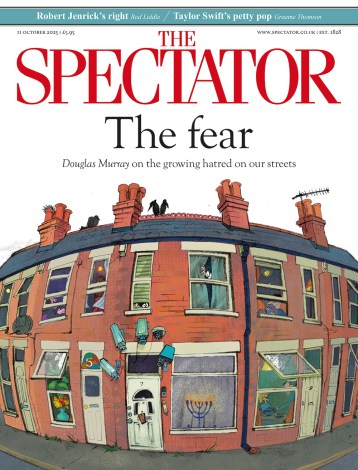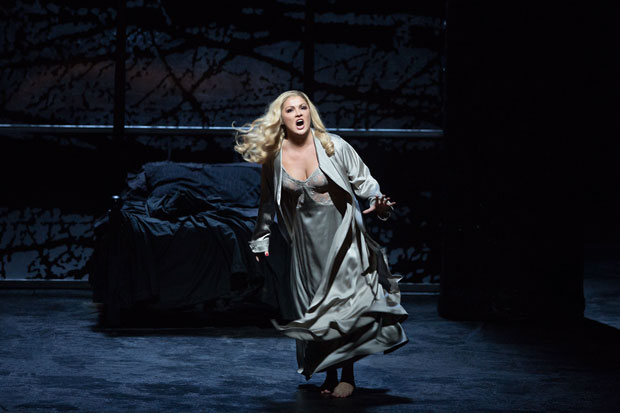This season of live Met relays got off to a most impressive start, with an electrifying account of Verdi’s tenth opera and first really great, though uneven piece, Macbetto (as I think it should be called; that’s what the central figure is called throughout). Fabio Luisi showed that he is far more at home conducting Verdi than Wagner — though his Bruckner performances are also magnificent. What made this the most stirring performance of Macbetto that I have seen was the strength of Željko Lucic’s performance in the title role. It is almost a cliché that the most interesting figure in the opera is ‘Lady’, as Verdi called her, but though Anna Netrebko gave as good as she got, the central tragic figure, with less to sing than his wife, and most of it less striking, remained the man who paradoxically commits his fearful deeds from weakness rather than from strength; and consequently elicits an unusual blend of feelings from the audience. Lucic is a singer we see far less of than we should: he is perhaps primarily an actor of great range and subtlety, but he has a large, firmly focused voice, the kind that is expressive in itself, though he is a fine user of the text, without being obtrusive; perfect, in fact.
Of course for the Met audience and no doubt many cinema viewers the centre of attention was Netrebko — who almost upstaged her performance in the opera by her hilarious interview in the intermission, insouciante, wicked English put to pungently idiosyncratic use. As Lady she first appeared as outrageously sexy, both in her singing — she now has a voluptuous voice — and in the extremity of her décolletage, which created a suspense all of its own, and still has me wondering. Her determination to get her husband to go ahead with Duncan’s murder seemed to be one more erotic game she played with him. Most famous performers of Lady have been mezzos, but Netrebko, though she has almost all the requisite lower notes, is a lyric soprano with an ever-expanding voice, in range and volume. The coloratura holds no terrors for her, but she was at her finest in the duets with Macbeth, and especially in the party scene where she tries to cover up Macbeth’s terror at Banquo’s ghost. No doubt the performance will appear on DVD; it is worthy of preservation.

The next Met relay was a new production of Le nozze di Figaro, the only opera there is a moral obligation to love. Richard Eyre, in a pre-performance interview, explained that he had updated it to the 1930s, thanks to the similarities with the 1780s, with impending catastrophe and ubiquitous sex — surely the Twenties rather than the Thirties? It didn’t make a lot of difference, though references to the droit du seigneur were ridiculous. There may never have been such a thing, but most of us have sufficiently vague historical imaginations to think there might have been in the 1780s, but nothing comparable in the 1930s.
My main complaint with Eyre’s production is that it is excessively broad, treating Mozart’s supreme masterpiece as farce rather than as comedy. We care about the characters in Figaro in a way that we never could care about any of those in Rossini’s comic operas and, as with all the most enthralling dramas, we share the anxieties, the miseries and the triumphs of the characters every time we see the work. Eyre did all he could to stop our caring, and the Met audience obediently applauded almost every aria so that James Levine’s superb conducting was constantly thwarted. Even so, that and a decent if not distinguished cast made the impact that Figaro always should, pondering the weakness of our humanity, our absurdity and occasional hard-won nobility. The Count needs re-casting: Peter Mattei, who is capable of powerful performances, was clearly ill at ease, looking and acting like Bertie Wooster lacking the support of Jeeves. The Count is an authoritative and sexy character, let down in Figaro not by his own flaws, but by treacherous chance. The one distinguished performance was the Cherubino of Isabel Leonard, convincingly androgynous and a sensuous singer.
By comparison, The Marriage of Figaro that I saw at ENO a few evenings later was wretched, even worse than the first time round. Since 2011 Fiona Shaw, the director, has thought up many new distractions, so that now the chances of concentrating on Mozart’s opera are virtually nil. Figaro appears in front of the curtain experimenting with scales on a harpsichord for a couple of distracting minutes before the overture begins. So far as I could judge, Jaime Martin’s conducting was good, if too considerate of the singers. But the musical side of things is upstaged passim by the hyperactivity of the set, which revolves, and the feverish behaviour of the singers, running to stay where they are at the same time as, if they are male, fiddling with their erections, while the Countess reaches for another brandy from her large selection of spirit comforts. The singing is mainly of a tolerable standard, but over the whole evening hung the pall of routine, something which I have never encountered before at the Coliseum
.







Comments